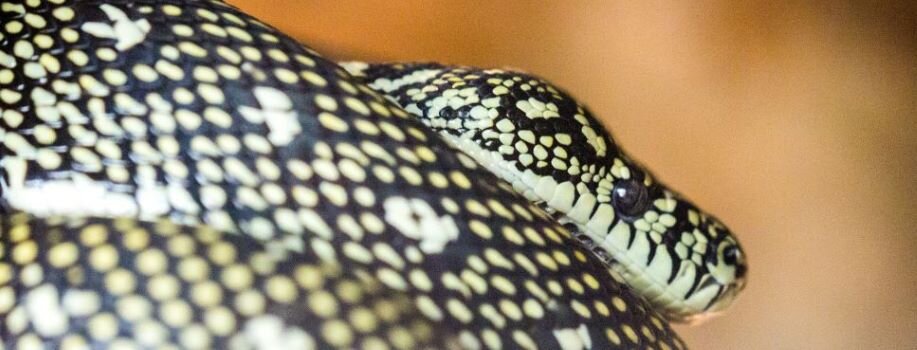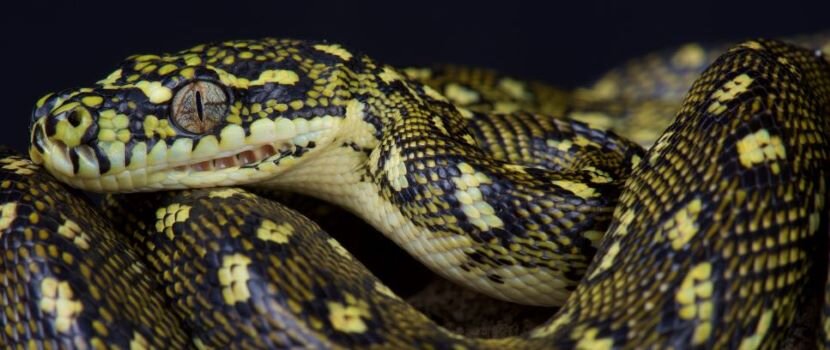Last Updated: 24/11/2025
Carpet and Diamond Pythons Guide
A complete guide for keeping Morelia spilota, Carpet and Diamond pythons in Australia
Author: Dr Nicole Wynne BSc BVMS MANZCVS (Unusual Pets)
Reading Time: 19 minutes - medium read
Carpet and Diamond pythons are great snakes for the intermediate reptile keeper, especially those who have already successfully kept smaller pythons like Stimson's and Children's pythons, and are looking for more of a challenge! Carpet and Diamond pythons are the same species, with Diamond pythons being a subspecies - Morelia spilota spilota. There are several other subspecies of carpet python:
- Jungle carpet python - Morelia spilota cheynei
- Coastal carpet python - Morelia spilota mcdowelli
- Inland carpet python - Morelia spilota metcalfei
- Darwin carpet python - Morelia spilota variegata
Many pet carpet pythons may be hybrids of two or more different subspecies, which is not a problem for pet snakes. However, breeding animals should have more controlled lineages, and the parentage of any breeding animals should be known.
Carpet pythons can grow up to 4 metres long and weigh 15 kg! The average adult length is about 2 metres, and females tend to get larger than males. Genetics also plays a part in the adult size of carpet pythons, with the Coastal subspecies being the largest, and the Darwin subspecies the smallest.
While carpet pythons are commonly kept as pets, they require some experience due to their size, strength, and temperament. Many carpet pythons are docile and easy to handle, but they can also be aggressive and difficult to handle depending on the individual and their level of human exposure. Females are more likely to be difficult to handle, and they also grow larger than males. These snakes can be very strong when fully grown, and although they are not venomous, their razor-sharp teeth can cause serious injury, so ensure that you are ready for a carpet python before committing to one.
Their size also means that an appropriate enclosure for an adult needs to be at least 150 cm long, 60 cm tall, and 100 cm wide. While juvenile snakes certainly can be kept in a smaller enclosure, always factor their adult size into account when planning, and smaller snakes can be kept in larger enclosures as long as there is no risk of escape. Hatchlings can be kept in plastic containers inside large enclosures.
Reptile Licensing Requirements in Australia
All pet reptiles require a reptile keeping licence in Australia, and these differ from state to state, so ensure that you check your local requirements before getting any pet reptile. For Carpet and Diamond pythons, the licensing requirements are generally aimed towards beginner and intermediate keepers.
NSW - Companion Animal Keeper's Licence
ACT - Nature Conservation Act Licence
VIC - Wildlife Basic Licence
WA - Fauna Pet Keepers Licence
TAS - Illegal for private keepers in Tasmania
QLD - Standard Recreational Wildlife Licence
NT - Permit to Keep Protected or Prohibited Wildlife
SA - No licence required to keep just one Morelia spp. python, Basic Licence otherwise.
Facts and FAQs About Carpet and Diamond Pythons

Preparing for your Carpet or Diamond Python
After getting your licence, the next step is putting together an enclosure for your python. Read through our checklist below for the supplies you'll need.
Carpet and Diamond Python Supplies Checklist
- Vivarium/tank
- Plastic storage container with ventilation holes for transport
- Substrate
- Hides and other furniture, such as big climbing branches
- Water dish
- Feeding tongs
- Appropriately sized frozen feeder mice or rats
- Enclosure cleaner
- Heat source
- UV light
- Thermostat
- An appointment at an exotics vet
Caring for Your Carpet or Diamond Python

Now that you've set up your enclosure, most of the hard work is done! The next thing to do is allow your snake to settle in and relax. In this time, make a booking with an exotics or reptile vet, as an initial checkup is important to ensure that everything is set up appropriately, and that your snake doesn't have any issues to look out for. The veterinarian will perform a full physical examination of your snake, and if you don't know the gender, they will be able to perform probe sexing to tell you if your snake is male or female.
Finally, the most important thing to remember when starting your reptile-keeping journey - enjoy! Reptiles are unique, interesting pets that have a lot of joy to give, and individuals will develop their own special personalities as time goes on. Pythons are rewarding pets, and the Carpet and Diamond pythons are majestic, impressive animals as adults.
Further Reading
Want to read more? Check out our other articles:
Beginners Guide to Reptile Care
History
Our experts continually monitor the health and wellness space and we update our articles when new information becomes available.
Mon 24 Nov 2025
Edited by Dr Olivia Clarke BSc BVMS MANZCVS (Unusual Pets, Avian)Medically reviewed by Dr Olivia Clarke BSc BVMS MANZCVS (Unusual Pets, Avian)Dr Nicole Wynne BSc BVMS MANZCVS (Unusual Pets)
Veterinarian, MANZCVS (Unusual Pets)
Dr. Nicole graduated from Murdoch University in WA in 2014, and immediately started working in exotics-only practice. She was also one of the few vets in Australia that would routinely see venomous snakes ranging from death adders to tiger snakes. Although Dr. Nicole enjoys seeing all exotic pets, her absolute favourite are rabbits. She passed her Australian and New Zealand College of Veterinary Scientists Membership (MANZCVS) exam in unusual and exotic pets in 2021.

